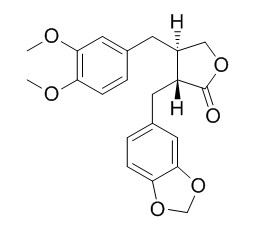Kusunokinin
Kusunokinin displays significant activity against intracellular amastigotes (IC(50) = 17 µM) and trypomastigotes (IC(50) = 51 µM) without hemolytic activity.
Inquire / Order:
manager@chemfaces.com
Technical Inquiries:
service@chemfaces.com
Tel:
+86-27-84237783
Fax:
+86-27-84254680
Address:
1 Building, No. 83, CheCheng Rd., Wuhan Economic and Technological Development Zone, Wuhan, Hubei 430056, PRC
Providing storage is as stated on the product vial and the vial is kept tightly sealed, the product can be stored for up to
24 months(2-8C).
Wherever possible, you should prepare and use solutions on the same day. However, if you need to make up stock solutions in advance, we recommend that you store the solution as aliquots in tightly sealed vials at -20C. Generally, these will be useable for up to two weeks. Before use, and prior to opening the vial we recommend that you allow your product to equilibrate to room temperature for at least 1 hour.
Need more advice on solubility, usage and handling? Please email to: service@chemfaces.com
The packaging of the product may have turned upside down during transportation, resulting in the natural compounds adhering to the neck or cap of the vial. take the vial out of its packaging and gently shake to let the compounds fall to the bottom of the vial. for liquid products, centrifuge at 200-500 RPM to gather the liquid at the bottom of the vial. try to avoid loss or contamination during handling.
Biomedicines.2022, 10(5):1170
Chinese Journal of Tissue Engineering Research2024, 28(8):1149-1154.
Food Chem X.2024, 24:101794.
Appl Biochem Biotechnol.2022, s12010-022-04166-2.
Chin J Appl. Physiol.2019, 35(3):283-288
Sci Rep.2024, 14(1):31213.
Evid Based Complement Alternat Med.2018, 2018:8565132
ScientificWorldJournal.2022, 2022:4806889.
Plant Sci.2020, 301:110656.
Front Mol Neurosci.2023, 15:1083189.
Related and Featured Products
Other References Information
Planta Med. 2010 Sep;76(13):1454-6.
Antitrypanosomal activity of a diterpene and lignans isolated from Aristolochia cymbifera.[Pubmed:
20301059 ]
Bioguided fractionation of extract from the leaves of Aristolochia cymbifera led to the isolation of the furofuran lignans fargesin, epieudesmin, and sesamin; the dibenzylbutyrolactone lignans hinokinin and Kusunokinin; and an ENT-labdane diterpene named copalic acid. Our data demonstrated that copalic acid and Kusunokinin were the most active compounds against trypomastigotes of Trypanosoma cruzi. Additionally, copalic acid demonstrated the highest parasite selectivity as a result of low toxicity to mammalian cells, despite a considerable hemolytic activity at higher concentrations. Among the isolated compounds, Kusunokinin could be considered the most promising candidate, as it displayed significant activity against intracellular amastigotes (IC(50) = 17 µM) and trypomastigotes (IC(50) = 51 µM) without hemolytic activity. Fargesin, hinokinin, epieudesmin, and sesamin were also effective against trypomastigotes, but these compounds were highly toxic to mammalian cells and no parasite selectivity could be identified. The need for novel drugs for American trypanosomiasis is evident, and these secondary metabolites from A. cymbifera represent a useful tool for drug design.



